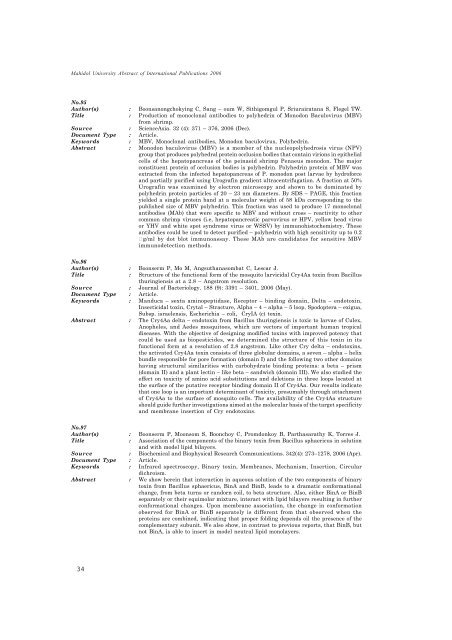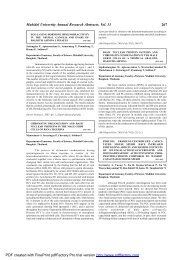2006 ที่น้องแอนทำ.pmd - Mahidol University
2006 ที่น้องแอนทำ.pmd - Mahidol University
2006 ที่น้องแอนทำ.pmd - Mahidol University
Create successful ePaper yourself
Turn your PDF publications into a flip-book with our unique Google optimized e-Paper software.
<strong>Mahidol</strong> <strong>University</strong> Abstract of International Publications <strong>2006</strong><br />
No.95<br />
Author(s) : Boonsanongchokying C, Sang – oum W, Sithigomgul P, Sriurairatana S, Flegel TW.<br />
Title : Production of monoclonal antibodies to polyhedrin of Monodon Baculovirus (MBV)<br />
from shrimp.<br />
Source : ScienceAsia. 32 (4): 371 – 376, <strong>2006</strong> (Dec).<br />
Document Type : Article.<br />
Keywords : MBV, Monoclonal antibodies, Monodon baculovirus, Polyhedrin.<br />
Abstract : Monodon baculovirus (MBV) is a member of the nucleopolyhedrosis virus (NPV)<br />
group that produces polyhedral protein occlusion bodies that contain virions in epithelial<br />
cells of the hepatopancreas of the peinaeid shrimp Penaeus monodon. The major<br />
constituent protein of occlusion bodies is polyhedrin. Polyhedrin protein of MBV was<br />
extracted from the infected hepatopancreas of P. monodon post larvae by hydroforce<br />
and partially purified using Urografin gradient ultracentrifugation. A fraction at 50%<br />
Urografin was examined by electron microscopy and shown to be dominated by<br />
polyhedrin protein particles of 20 – 23 nm diameters. By SDS – PAGE, this fraction<br />
yielded a single protein band at a molecular weight of 58 kDa corresponding to the<br />
published size of MBV polyhedrin. This fraction was used to produce 17 monoclonal<br />
antibodies (MAb) that were specific to MBV and without cross – reactivity to other<br />
common shrimp viruses (i.e, hepatopancreatic parvovirus or HPV, yellow head virus<br />
or YHV and white spot syndrome virus or WSSV) by immunohistochemistry. These<br />
antibodies could be used to detect purified – polyhedrin with high sensitivity up to 0.2<br />
g/ml by dot blot immunoassay. These MAb are candidates for sensitive MBV<br />
immunodetection methods.<br />
No.96<br />
Author(s) : Boonserm P, Mo M, Angsuthanasombat C, Lescar J.<br />
Title : Structure of the functional form of the mosquito larvicidal Cry4Aa toxin from Bacillus<br />
thuringiensis at a 2.8 – Angstrom resolution.<br />
Source : Journal of Bacteriology. 188 (9): 3391 – 3401, <strong>2006</strong> (May).<br />
Document Type : Article.<br />
Keywords : Manduca – sexta aminopeptidase, Receptor – binding domain, Delta – endotoxin,<br />
Insecticidal toxin, Crytal – Stracture, Alpha – 4 – alpha – 5 loop, Spodoptera – exigua,<br />
Subsp. israelensis, Escherichia – coli, CryIA (c) toxin.<br />
Abstract : The Cry4Aa delta – endotoxin from Bacillus thuringiensis is toxic to larvae of Culex,<br />
Anopheles, and Aedes mosquitoes, which are vectors of important human tropical<br />
diseases. With the objective of designing modified toxins with improved potency that<br />
could be used as biopesticides, we determined the structure of this toxin in its<br />
functional form at a resolution of 2.8 angstrom. Like other Cry delta – endotoxins,<br />
the activated Cry4Aa toxin consists of three globular domains, a seven – alpha – helix<br />
bundle responsible for pore formation (domain I) and the following two other domains<br />
having structural similarities with carbohydrate binding proteins: a beta – prism<br />
(domain II) and a plant lectin – like beta – sandwich (domain III). We also studied the<br />
effect on toxicity of amino acid substitutions and deletions in three loops located at<br />
the surface of the putative receptor binding domain II of Cry4Aa. Our results indicate<br />
that one loop is an important determinant of toxicity, presumably through attachment<br />
of Cry4Aa to the surface of mosquito cells. The availability of the Cry4Aa structure<br />
should guide further investigations aimed at the molecular basis of the target specificity<br />
and membrane insertion of Cry endotoxins.<br />
No.97<br />
Author(s) : Boonserm P, Moonsom S, Boonchoy C, Promdonkoy B, Parthasarathy K, Torres J.<br />
Title : Association of the components of the binary toxin from Bacillus sphaericus in solution<br />
and with model lipid bilayers.<br />
Source : Biochemical and Biophysical Research Communications. 342(4): 273–1278, <strong>2006</strong> (Apr).<br />
Document Type : Article.<br />
Keywords : Infrared spectroscopy, Binary toxin, Membranes, Mechanism, Insertion, Circular<br />
dichroism.<br />
Abstract : We show herein that interaction in aqueous solution of the two components of binary<br />
toxin from Bacillus sphaericus, BinA and BinB, leads to a dramatic conformational<br />
change, from beta turns or randorn coil, to beta structure. Also, either BinA or BinB<br />
separately or their equimolar mixture, interact with lipid bilayers resulting in further<br />
conformational changes. Upon membrane association, the change in conformation<br />
observed for BinA or BinB separately is different from that observed when the<br />
proteins are combined, indicating that proper folding depends oil the presence of the<br />
complementary subunit. We also show, in contrast to previous reports, that BinB, but<br />
not BinA, is able to insert in model neutral lipid monolayers.<br />
34
















